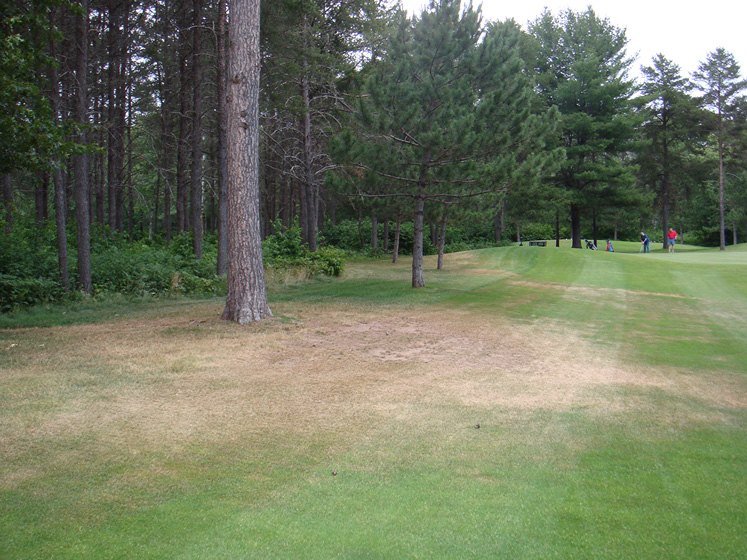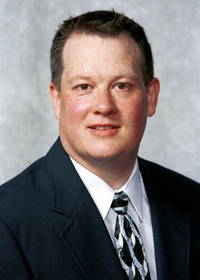Selecting and Managing Turfgrass for Shade
The most important factor in selecting what grass to grow is the amount of sunlight and shade you have. No species of turfgrass will grow in complete shade. This guide helps homeowners and landscapers choose the appropriate grass type for different situations and learn how to better manage shaded areas.
Why Is Sunlight Important?
Plants obtain energy by capturing sunlight to perform photosynthesis. Photosynthesis is the process of converting light energy into chemical energy, such as sugars and starches. Turfgrass lawns are important fixtures of most urban landscapes; however, trees and buildings often decrease light levels to the detriment of the desirable turf. While trees are an integral part of landscapes, they compete with turf for resources, such as water, sunlight, and nutrients (Figure 1).

When grown in shade, bermudagrass experiences elongated stems and internodes, weak rhizomes, decrease in turf density, decrease in canopy photosynthetic rates, and reduced root biomass. Shaded warm-season turfgrasses, such as bermudagrass, often lack lateral stem growth and development. Shaded cool-season turfgrasses, such as tall fescue, may have increased incidences of disease.
Selecting the Right Turf
Bermudagrass requires the most light of all maintained turfgrasses, followed by carpetgrass, bahiagrass, zoysiagrass, centipedegrass, Kentucky bluegrass, tall fescue, and red fescue. St. Augustinegrass is the most shade-tolerant of warm-season turfgrasses—it requires approximately 4 hours of direct sunlight or a full day of high-quality, filtered sunlight. See Table 1 for a detailed list of grasses and their shade tolerance.
|
Turfgrass |
Scientific Name |
Shade Tolerance |
Sprigs and Sod |
Seeded |
|---|---|---|---|---|
|
St. Augustinegrass |
Stenotaphrum secundatum |
excellent |
Raleigh, Palmetto, others |
no |
|
Manila zoysiagrass |
Zoysia matrella |
good |
Cavalier, Diamond, Zeon, Royal, Zorro, and many others |
no |
|
Japanese zoysiagrass |
Zoysia japonica |
good |
Meyer, El Toro, JaMur, Palisades, Empire, Empress |
Zenith and others |
|
centipedegrass |
Eremochloa ophiuroides |
medium |
TifBlair, Oaklawn, TennTurf |
TifBlair, Centiseed, others |
|
broadleaf carpetgrass |
Axonopus compresus |
medium |
not commonly available |
yes |
|
common carpetgrass |
Axonopus fissifolius |
medium |
not commonly available |
yes |
|
seashore paspalum |
Paspalum vaginatum |
poor |
several but not recommended for home lawns in Mississippi |
Seaspray and others |
|
bahiagrass |
Paspalum notatum |
poor |
Common, Argentine, Pensacola |
yes |
|
bermudagrass |
Cynodon spp. |
very poor |
328, MS-Choice, MS-Pride, Celebration, TifWay 419, TifGreen, TifGrand |
many |
|
buffalograss |
Buchloe dactyloides |
very poor |
not commonly available |
many |
Modified from Beard and Beard, 2005.
Bermudagrass (Cynodon spp.) continues to be Mississippi’s preferred turfgrass because of its wide adaptation to climates and soil types, high density, dark green color, aggressive growth habit, and good wear tolerance, but it often performs poorly in shady areas. In fact, bermudagrass is considered to have the least shade tolerance relative to other popular warm-season turfgrasses. Recent breeding efforts have released new bermudagrass cultivars with “improved” shade tolerance. ‘TifGrand’ and ‘Celebration’ bermudagrasses have shown promise under moderate shade conditions; however, they are by no means shade tolerant.
Managing Your Shaded Yard
Sound agronomic practices are the cornerstone of turfgrass management under shade and other stressful environmental conditions. (For a full description, see Extension Publication 1322 Establish and Manage Your Home Lawn.) Appropriate nitrogen use, mowing practices, and irrigation volume can minimize negative effects of shade. If you currently have an area of thin turfgrass due to shade, below are a few tips to help improve the look of your yard.
Fertility
Nitrogen is often the most limiting nutrient for turfgrasses. This vital nutrient promotes color, density, recuperative ability, and plant health when applied at adequate rates. However, if a recommended nitrogen fertilization program under full sunlight (Publication 1322) is applied over areas under shade, a decline in turfgrass may follow. Shaded plants will grow taller in an effort to outcompete the source of shade. Meanwhile, nitrogen fertilization tends to encourage rapid vertical growth. The combination of the two will result in a plant that puts all of its energy reserves into shoot growth at the expense of root growth. Furthermore, when the area is mown, excessive shoot growth will be removed, which adds another stress to the plant. While it may be tempting to add a little extra nitrogen to get your grass to grow under shade, applying normally recommended nitrogen rates will enhance a turfgrass stand when light interception is limited.
Raise Mowing Height
Mowing height is a critical management practice for successful turfgrass stands grown in shade. Plants are unique organisms for their ability to capture sunlight and convert this energy into food for the plant (photosynthesis). Simply raising the height of cut should enhance shade tolerance by allowing a greater leaf surface for solar absorption.
Reduce Traffic
Foot traffic, whether from pets or people, can cause excessive stress for shaded turf, eventually leading to decline. Mowing is also a form of traffic that should be reduced when possible. In fact, under many shade trees, the wheels of riding lawn mowers are a main cause of turf decline. Combine increased mowing heights with string-trimming, or use mulch under the drip-line of trees that require a tight turning pattern.
Irrigation
Irrigation is often difficult to manage because of the many variables that come with irrigation scheduling. In general, areas under shade are less vigorous, cooler, and have reduced evapotranspiration rates compared to full-sunlight environments. All of this adds up to a reduced water requirement. However, at times, turf areas under shade may require additional water due to tree root competition (Figure 2). Wilting turf is an indication watering is needed.

How Much Light Does Your Lawn Receive?
Chances are, you may not know the answer to this question. However, this is a critical question to consider before removing trees, changing cultural practices, or resodding to improve the performance of your lawn. There are several methods to determine how much light your lawn receives. The most common is to observe your lawn throughout the day on the hour and note whether an area is shaded. Since sunlight quality, day length, and sun angle vary at different times of the year, it is difficult to predict exactly how much light a lawn receives, but an estimate made this way is often good enough to make an initial assessment.
When choosing and maintaining turfgrass for shade—
- St. Augustinegrass is the most shade tolerant. Bermudagrass requires the most light of all maintained turfgrasses, followed by carpetgrass, bahiagrass, zoysiagrass, centipedegrass, Kentucky bluegrass, tall fescue, and red fescue.
- Apply normally recommended nitrogen rates to enhance a shaded turfgrass stand, but do not apply excess because this can negatively impact turf shade tolerance.
- Increasing the mowing height for shaded grasses will enhance sunlight-capturing ability and improve the turfgrass performance of this area of your yard.
- All traffic, whether from pets or people, can cause excessive stress for shaded turf.
- In general, the shaded areas of your yard will require less water than areas that receive full sunlight, but beware of tree competition for soil moisture.
The information given here is for educational purposes only. References to commercial products, trade names, or suppliers are made with the understanding that no endorsement is implied and that no discrimination against other products or suppliers is intended.
Publication 2892 (POD-07-21)
By Jay McCurdy, PhD, Associate Professor, and Christian Baldwin, PhD, former Associate Professor, Plant and Soil Sciences.
The Mississippi State University Extension Service is working to ensure all web content is accessible to all users. If you need assistance accessing any of our content, please email the webteam or call 662-325-2262.





